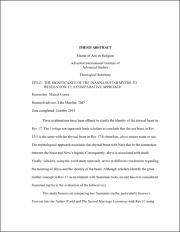The Significance of the inanna/ishtar myths to Revelation 17 : a comparative approach
Abstract
Three explanations have been offered to clarify the identity of the abyssal beast in
Rev 17. The Vorlage text approach leads scholars to conclude that the sea beast in Rev
13:1 is the same with the abyssal beast in Rev 17:8; therefore, abyss means water or sea.
The mythological approach associates the abyssal beast with Nero due to the connection
between the beast and Nero’s legend. Consequently, abyss is associated with death.
Finally, scholars, using the word study approach, arrive at different conclusions regarding
the meaning of abyss and the identity of the beast. Although scholars identify the great
mother concept in Rev 17 as an element with Sumerian roots, no one has ever considered
Sumerian myths in the evaluation of the biblical text.
This study focuses on comparing two Sumerian myths, particularly Inanna’s
Descent into the Nether World and The Sacred Marriage Ceremony with Rev 17 using
the comparative approach. In comparing Rev 17 with the abovementioned myths, this
thesis employs Shemaryahu Talmon’s approach. Talmon presents four principles:
namely, the proximity in time and place, correspondence of social function, priority of
inner-biblical parallels, and holistic approach to text and comparisons.
This thesis concludes that Rev 17 and the Inanna/Ishtar myths have some
similarities as well as differences. On the one hand, the similarities attest that John writes
with the background of the Sumerian myths in Rev 17. On the other hand, the differences
prove that the prophet employs the Sumerian ideas in Rev 17 to highlight the uniqueness
of the biblical narrative. Although the primary source of Rev 17 is Dan 7, the composite
symbol of the woman and the beast is unique to Rev 17. Perhaps in the description of the
harlot riding the beast, John employs the Sumerian myths. The use of the Sumerian myths
in Revelation could attest to the practice of a common worldview, the great mother
goddess.
It seems that John employs the Sumerian myths in juxtaposition to the biblical
narrative. The Sacred Marriage Ceremony stresses the importance of the union of politics
and religion, whereas the biblical account exposes the danger of this union. The myth
Inanna’s Descent into the Nether World declares that although the goddess and Dumuzi
died, they resurrected according to the cyclical element that connects this myth with The
Sacred Marriage Ceremony. Nonetheless, John comments that the beast/kings are
resurrected to die forever.


